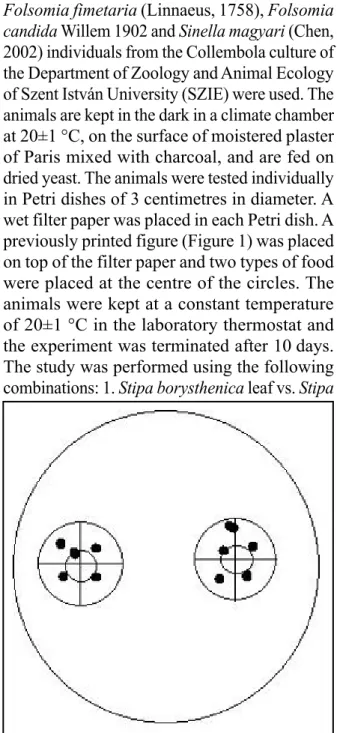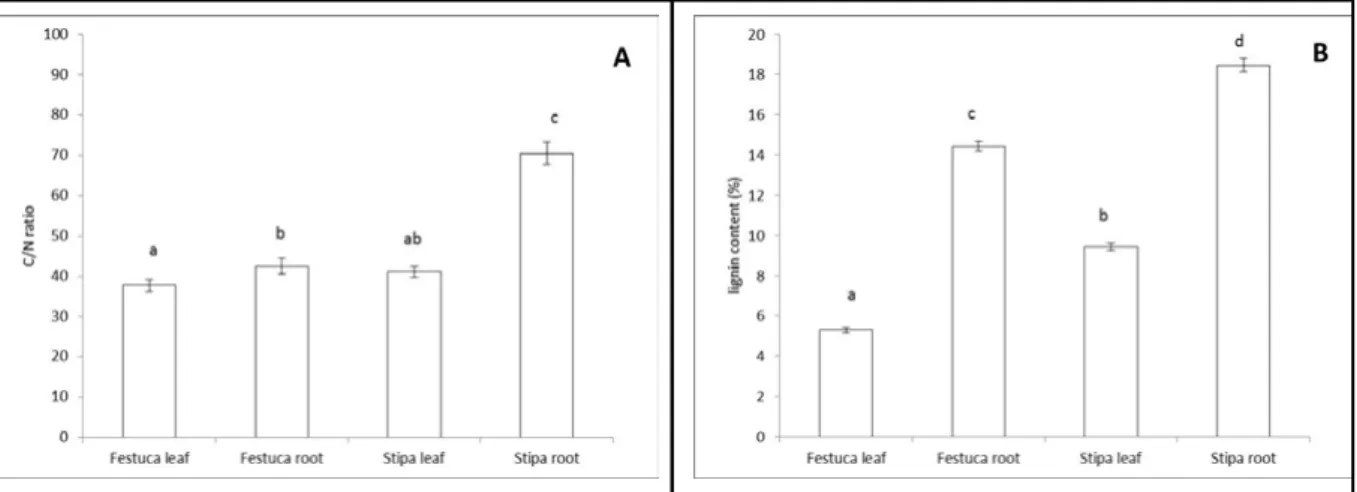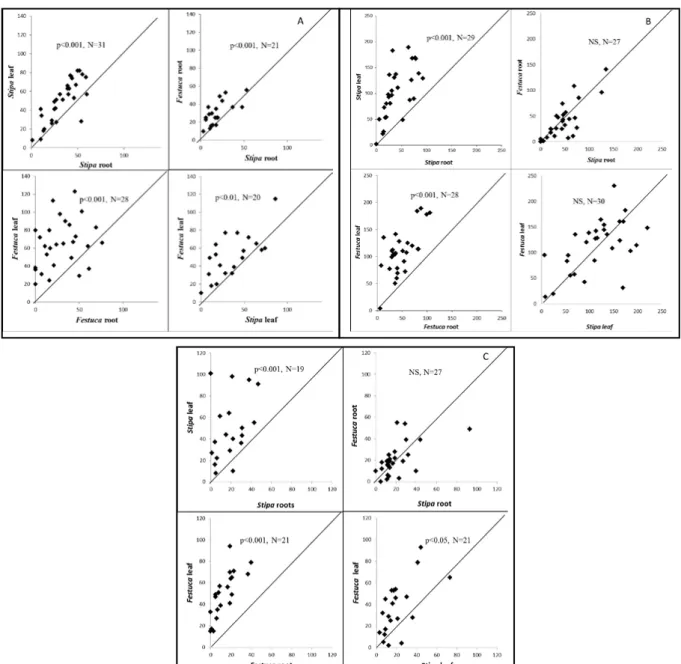Feeding preference of three Collembola species on two plant residues
Anikó SERES1 – Judit SZAKÁLAS1– Gergely BOROS1, 3– Gábor ÓNODI2 – György KRÖEL-DULAY2– Péter NAGY1
1: Szent István University, Department of Zoology and Animal Ecology, Páter K. u. 1, H-2100 Gödöllő, E-Mail: seres.aniko@mkk.szie.hu
2: MTA Centre for Ecological Research, Institute of Ecology and Botany Alkotmány 2-4, H-2163 Vácrátót, Hungary
3: MTA Centre for Ecological Research, GINOP Sustainable Ecosystem Research Group, 8237 Tihany, Klebelsberg Kunó u. 3. Hungary
Abstract: This study formed the part of an extended climate change experiment that focuses on the ways climate change may affect the species composition and the ecological processes of vulnerable open sand grasslands. The project is conducted in a natural shrubland-grassland ecosystem in the Kiskunság National Park. This is an arid area, and the members of macrofauna are almost completely lacking from these soils. Collembola presumably plays an important role in the direct decomposition processes, beyond the indirect regulation of the microbiota. Previously, we found a higher decomposition rate for grass leaves as compared to grass roots and faster decomposition of one dominant grass species (Festuca vaginata) over the other (Stipa borysthenica) in this experimental system.
In the present study, we investigated in a laboratory experiment, whether higher decomposition rate may be related to food preference of potential decomposer species in the system, and posed the following questions: (i) is there a preference in the food choice of three springtails species (Folsomia fimetaria, F. candida, Sinella magyari) between the roots and leaves of the two dominant plant species (Stipa borythenica, Festuca vaginata) and between the roots and leaves of the same species? (ii) can the C/N ratio and lignin content of plants as background variable explain such preference?
Significant differences were found in the food preference of all Collembola species between the two parts of the plants and in some case between the two plant species. The leaves and Festuca vaginata were more preferred food type as compared to roots and Stipa borysthenica. The chemical composition of the plant parts well explained the observed patterns, especially the N and lignin content of the leaves and roots.
Keywords: springtails, food preference, decomposition, fecal pellet count, Folsomia candida
Introduction
Dead organic matter (DOM) decomposition is of key importance in the nutrient cycle of grasslands.
Changes in the DOM content of soils as a result of climate change is a priority research area as climate, particularly soil temperature and humidity, are important factors of the decomposition rate (Kirschbaum 1995; van Meeteren et al. 2008;
Smith 2012). Besides, the quality, i.e. the chemical composition of the organic residuum entering into the soil is also a crucial parameter of the decomposition (Swift et al. 1979; Aerts 1997;
Almagro and Martinez-Mena 2012). The third determining factor of the decomposition is the qualitative composition and the quantity of
organisms involved in the process (soil animals, microbes). Soil fauna plays a well-known role in the fragmentation of plant parts, making the organic matter accessible to microbes involved in chemical decomposition. Members of the macrofauna (annelids, woodlice and diplopods) take the main role in this process (Slade and Riutta 2012; Pant et al. 2017). In extremely dry habitats such as open sand grasslands, the majority of macrofauna is absent. According to literature data and field experience (Lawrence 2000; Filser 2002), it is assumed that springtails are not only indirectly involved in decomposing processes by controlling populations of microorganisms (bacteria, fungi) in this habitat but also directly, by consuming plant parts.
Most Collembola species have a wide food spectrum. They may consume, among others, different mosses, plant parts, dead organic matter, fungal spores or hyphae, bacteria, nematodes, alga cells and lichens (Anderson and Healey 1972; Bakonyi et al. 1994; Bakonyi 1998;
Gilmore and Potter 1993). Moreover, they may play an important role in the dissemination of saprophytic and mycorrhizal fungi found in soil (Seres et al. 2007, 2009). Several studies have found that these microarthropods are able to choose between the foods provided on a fine scale and select their diet according to their needs, avoiding foods that are of insufficient quality (Bakonyi et al. 2006).
Study investigating the structure of springtail communities in the study area (Kiskunság National Park, central Hungary) found one species, Entomobrya nigriventris, with strong dominance in the community (Flórián et al.
2016). This species has very specific needs, so it is not easy to keep it in laboratory cultures.
However, the same study detected the presence of Folsomia candida, a species easily kept under laboratory conditions, in the area.
Present study formed the part of an extended climate change experiment that focuses on the ways climate change may affect the species composition and the ecological processes of vulnerable open sand grassland. This experiment is conducted in a natural shrubland-grassland ecosystem in the Kiskunság National Park, central Hungary (N 46.871°, E 19.421°). Previously, we examined the decomposition of organic matter in this sand grassland through different methods (Seres et al. 2015). An important aspect of the study was that both plant species and plant parts had a significant effect on the rate of decomposition. A higher weight loss was detected in the case of Festuca vaginata than Stipa borysthenica and the leaves than the roots of the dominate grasses. This implies that the chemical quality of the plant strongly affects the rate of decomposition. The present study was designed in the light of the above results.
The questions were as follows: (i) is there a preference in the food choice of three springtail
species (Folsomia fimetaria, F. candida, Sinella magyari) between the roots and leaves of two dominant plant species (Stipa borythenica, Festuca vaginata) and between the roots and leaves of the same species? (ii) can the C/N ratio and lignin content of plants as background variable explain such preference?
Methods
Folsomia fimetaria (Linnaeus, 1758), Folsomia candida Willem 1902 and Sinella magyari (Chen, 2002) individuals from the Collembola culture of the Department of Zoology and Animal Ecology of Szent István University (SZIE) were used. The animals are kept in the dark in a climate chamber at 20±1 °C, on the surface of moistered plaster of Paris mixed with charcoal, and are fed on dried yeast. The animals were tested individually in Petri dishes of 3 centimetres in diameter. A wet filter paper was placed in each Petri dish. A previously printed figure (Figure 1) was placed on top of the filter paper and two types of food were placed at the centre of the circles. The animals were kept at a constant temperature of 20±1 °C in the laboratory thermostat and the experiment was terminated after 10 days.
The study was performed using the following combinations: 1. Stipa borysthenica leaf vs. Stipa
Figure 1. Experimental design. Outer circle: Petri dish of 3 cm. Food was placed at the centre of smaller circles and fecal pellets were counted within the larger ones.
Black dots symbolises fecal pellets.
borythenica root, 2. Festuca vaginata leaf vs.
Festuca vaginata root, 3. Stipa borysthenica leaf vs. Festuca vaginata leaf, 4. Stipa borysthenica root vs. Festuca vaginata root. The number of replicates was 20 to 30 with each Collembola species, using four treatments. The number of fecal pellets within the larger circle around the food was counted after 10 days of incubation. As the metabolism of springtails is high, they defecate where they feed; therefore, the number of fecal pellets in the direct vicinity of food sources may be a measure of the food (Bakonyi et al. 2006).
The C, N and lignin content of Stipa borysthenica and Festuca vaginata leaves and roots was determined. The analysis of C, N content was performed by the Department of Chemistry of SZIE, using a Carlo-Erba NA 1500 elemental analyser, while the analysis of lignin content took place at the Department of Animal Nutrition of SZIE, according to the method developed by van Soest (van Soest 1963).
Statistical analyses were performed using the R software package (R Core Team 2013); after checking assumptions for use of analysis, the C, N, and lignin content data of plants was analysed by one-way ANOVA followed by Tukey’s post-hoc test. After confirming that the data distribution is normal, GLM was used with fix and random factors, with dependent variables being the number of fecal pellets. Fix factor was the plant type, while the number of Petri-dishes was used as random factor.
Results
Statistical analyses clearly found significant differences between plant parts in C/N ratio and lignin content (Figure 2). In terms of food preference, the two most important parameters seem to follow this pattern. The C/N ratio of plant parts increased in the following order:
Festuca leaf, Stipa leaf, Festuca root, Stipa root (Figure 2A). The same order was observed for the increase of lignin content, which is a hardly digestible component in plant parts (Figure 2B).
The C and N content were the following in the Festuca leaf, Festuca root, Stipa leaf and Stipa roots, respectively. The ANOVA (F-value: 39 and 328) found significant difference in these values. The results of post hoc comparison are in brackets. The C content: 45.19±0.71 (bc), 44.06±0.34 (b), 46.71±0.11 (c), 40.51±171 (a).
The N content: 1.20±0.03 (c), 1.04±0.04 (b), 1.13±0.04 (c), 0.57±0.02 (a).
Significant differences were found in some cases in the food preference of Collembola between the two plant parts and the two species. Results show clearly that F. fimetaria had a preferred food in each combination (Figure 3A), F. candida (Figure 3B) and S. magyari (Figure 3C) showed preference in two and three out of four cases, respectively. F. fimetaria eat more on the leaves of both species than the roots, and preferred both the leaves and roots of F. vaginata rather than S. borysthenica (Figure 3A). F. candida did not select between the two grass species. The
Figure 2. The C/N ratio (A) and lignin content (B) of plant parts provided during preference tests. Different letters show statistically confirmed differences for a given variable (Tukey’s test, p<0.05).
preference of leaves was clear in the case of both species (Figure 3B). S. magyari had also great preference for the leaves of the grasses, rather than roots. They eat more on the leaves of F.
vaginata then the leaves of S. borysthenica. But we did not find preference between the roots of the two grass species, in the case of S. magyari.
The leaves (from the two plant parts) and F.
vaginata (from the two plant species) were the more preferred food types, in that case where preference occurred.
Discussion
The results of the present food preference tests provide an adequate explanation to the findings of previous field studies (Seres et al. 2015) as a preference for grass species or plant parts with a higher rate of decomposition was clearly demonstrated. The food preference of springtails was driven in our study by two factors: the lignin content and the C/N ratio of food. According to Larsen et al. (2008), Collembola usually choose
Figure 3. Number of fecal pellets near the two different food sources and results of the linear model (p<0.05:*, p<0.01:**, p<0.001 :***). One point means the data of one individually kept Collembola. A: Folsomia fimetaria, B: Folsomia candida, C: Sinella magyari.
foods with a higher N content and a lower C/N ratio. This pattern was evident in the present case. Collembola did not choose the food with the lowest N content (Stipa root) at all, while the food with the highest N content (Festuca leaf) was almost always preferred over the others. The other important aspect of food preference is the lowest possible amount of substances that are hard to digest (Rincon and Martinez 2006). As the content of lignin, a hardly digestible substance, increased in the same order in plant matter as N content decreased, the phenomenon described above stands for this component as well.
Springtails could be divided into different feeding guilds, but most of them feed on fungi in the soil (Berg et al. 2004). However, it has become well known that the composition of their food may be extremely diverse. An increasing number of studies have found in the past years that these animals consume dead plant matter and living plants as well (Malcika et al. 2017). This is confirmed also by the present study, although it should be noted that no alternative food was
available to animals in this experimental setting.
According to N isotope studies by Chahartaghi et al. (2005), these animals cannot be classified into any specific feeding guild as they are able to switch to other food in the case of changes in food availability.
The Collembola species involved in this study avoided foods with high lignin (and low N) content under laboratory conditions, supporting field findings (Seres et al. 2015). Based on the above, it is assumed that the similar patterns seen under laboratory and field conditions are caused by the fact that springtails are directly involved in the decomposition of organic matter in this extremely dry habitat. The monitoring of changes in springtail populations is therefore particularly important in terms of the nutrient cycle of protected sand grasslands in Hungary.
Acknowledgment
This study was supported by the ÚNKP-17- 4 New National Excellence Program of the Ministry of Human Capacities.
References
Aerts, R. (1997): Climate, leaf litter chemistry and leaf litter decomposition in terrestrial ecosystems: a triangular relationship. Oikos 79: 439-449. DOI: https://doi.org/10.2307/3546886
Almagro, M., Martinez-Mena, M. (2012): Exploring short-term leaf-litter decomposition dynamics in a Mediter- ranean ecosystem: dependence on litter type and site conditions. Plant Soil 358 (1): 323-335. DOI: https://
doi.org/10.1007/s11104-012-1187-6
Anderson, J. M., Healey, I. N. (1972): Seasonal and Inter-Specific Variation in Major Components of the Gut Contents of Some Woodland Collembola. J. Anim. Ecol. 41(2): 359-368. DOI: https://doi.org/10.2307/3473 Bakonyi, G. (1998): Nitrogen turnover of Sinella coeca (Collembola: Entomobryidae). Eur. J. Entomol. 95: 321-326.
Bakonyi, G., Dobolyi, C., Le, B. T. (1994): 15N uptake by collembolans from bacterial and fungal food source. Acta Zool. Fenn. 194: 136-138.
Bakonyi, G. Szira, F. Kiss, I., Villányi, I., Seres, A., Székács, A. (2006): Preference tests with collembolas on isogenic and Bt-maize. Eur. J. Soil Biol. 42: 132-135. DOI: https://doi.org/10.1016/j.ejsobi.2006.06.005
Berg, M. P., Stoffer, M. van den Heuvel, H. H. (2004): Feeding guilds in Collembola based on digestive enzymes.
Pedobiologia, 48(5-6): 589-601. DOI: https://doi.org/10.1016/j.pedobi.2004.07.006
Chahartaghi, M., Langel R., Scheu S., Ruess L. (2005) Feeding guilds in Collembola based on nitrogen stable iso- tope ratios. Soil Biol. Biochem. 37: 1718-1725. DOI: https://doi.org/10.1016/j.soilbio.2005.02.006
Filser, J. (2002): The role of Collembola in carbon and nitrogen cycling in soil: Proceedings of the Xth international Colloquium on Apterygota, České Budějovice 2000: Apterygota at the Beginning of the Third Millennium.
Pedobiologia, 46(3-4): 234-245. DOI: https://doi.org/10.1078/0031-4056-00130
Flórián, N. Dányi, L., Kröel-Dulay, Gy. Ónodi, G., Dombos, M. (2016): Repeated drought effects on the soil mi- croarthropod communities of a sand steppe. Abstract book of XVII International Colloquium on Soil Zool- ogy, p.59.
Gilmore, S. K., Potter, D. A. (1993): Potential role of Collembola as biotic mortality agents for entomopathogenic nematodes. Pedobiologia 37: 30-38.
Kirschbaum, M.U.F. (1995): The temperature dependence of soil organic matter decomposition, and the ef- fect of global warming on soil organic C storage. Soil. Biol. Biochem. 27 (6): 753–760. DOI: https://doi.
org/10.1016/0038-0717(94)00242-S
Larsen, J., Johansen, A., Larsen, S. E., Heckmann, L. H., Jakobsen, I., Krogh, P. H. (2008): Population performance of collembolans feeding on soil fungi from different ecological niches. Soil Biol. Biochem. 40: 360-369. DOI:
https://doi.org/10.1016/j.soilbio.2007.08.016
Lawrence, K. L., Wise, D. H. (2000): Spider predation on forest-floor Collembola and evidence for indirect effects on decomposition. Pedobiologia, 44(1): 33-39.DOI: https://doi.org/10.1078/S0031-4056(04)70026-8
Malcika, M., Berg, M.P., Ellers, J. (2017): Ecomorphological adaptations in Collembola in relation to feeding strate- gies and microhabitat. Eur. J. Soil Biol. 78: 82-91.DOI: https://doi.org/10.1016/j.ejsobi.2016.12.004
Pant, M., Negi, G.C.S., Kumar, P. (2017): Macrofauna contributes to organic matter decomposition and soil quality in Himalayan agroecosystems, India. Appl. Soil Ecol. 120: 20-29. DOI: https://doi.org/10.1016/j.ap- soil.2017.07.019
R Core Team (2013): R: A language and environment for statistical computing. R Foundation for Statistical Com- puting, Vienna, Austria. ISBN 3-900051-07-0, URL http://www.R-project.org/.
Rincón, J., Martínez, I. (2006): Food quality and feeding preferences of Phylloicus sp. (Trichoptera:Calamocer- atidae). Freshwater Science. 25 (1): 209-215. DOI: https://doi.org/10.1899/0887-3593(2006)25[209:FQAF- PO]2.0.CO;2
Seres, A., Bakonyi, G., Posta, K (2007): Collembola (Insecta) disperse the arbuscular mycorrhizal fungi in the soil:
pot experiment. Polish Journal of Ecology 55 (2): 395-399
Seres, A., Posta, K., Bakonyi, G., Nagy, P., Kiss, I., Fábián, M., Répási, V., Nosek, J.N. (2009): Collembola decrease the nitrogen uptake of maize through arbuscular mycorrhiza. Ekologia/Ecology (Bratislava) 28 (3): 242-247.
DOI: https://doi.org/10.4149/ekol_2009_03_242
Seres, A, Tóth, Zs., Hornung, E., Pörneki, A., Szakálas, J., Nagy, P. I., Boros, G., Ónodi, G., Kröel-Dulay Gy. (2015):
Szerves anyag lebomlás vizsgálatok módszertani kérdései egy védett homokpusztagyep talajában. Természet- védelmi Közlemények 21: 262-270.
Slade E.M., Riutta T. (2012): Interacting effects of leaf litter species and macrofauna on decomposition in different litter environments. Basic Appl. Ecol. 13: 423-431. DOI: https://doi.org/10.1016/j.baae.2012.06.008
Smith, P. (2012): Soils and climate change. Curr. Opin. Environ. Sustainability 4: 539–544. DOI: https://doi.
org/10.1016/j.cosust.2012.06.005
Swift, M. J., Heal, W. O., Anderson J. M. (1979) Decomposition in Terrestrial Ecosystems. Studies in Ecology, Vol.5.
Blackwell Scientific, Oxford, UK
van Meeteren, M. J. M., Tietema, A., van Loon, E. E., Verstraten, J. M. (2008): Microbial dynamics and litter decomposition under a changed climate in a Dutch heathland. Appl. Soil Ecol. 38:119–127. DOI: https://doi.
org/10.1016/j.apsoil.2007.09.006
van Soest, P. J. (1963): Use of detergents in the analysis of fibrous feeds. II. A rapid method for the determination of fiber and lignin. J. Assoc. Off. Anal. Chem. 46: 829-835.


